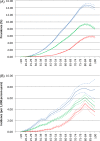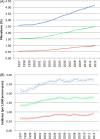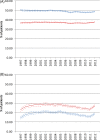Rising burden of gout in the UK but continuing suboptimal management: a nationwide population study
- PMID: 24431399
- PMCID: PMC4392307
- DOI: 10.1136/annrheumdis-2013-204463
Rising burden of gout in the UK but continuing suboptimal management: a nationwide population study
Abstract
Objectives: To describe trends in the epidemiology of gout and patterns of urate-lowering treatment (ULT) in the UK general population from 1997 to 2012.
Methods: We used the Clinical Practice Research Datalink to estimate the prevalence and incidence of gout for each calendar year from 1997 to 2012. We also investigated the pattern of gout management for both prevalent and incident gout patients.
Results: In 2012, the prevalence of gout was 2.49% (95% CI 2.48% to 2.51%) and the incidence was 1.77 (95% CI 1.73 to 1.81) per 1000 person-years. Prevalence and incidence both were significantly higher in 2012 than in 1997, with a 63.9% increase in prevalence and 29.6% increase in incidence over this period. Regions with highest prevalence and incidence were the North East and Wales. Among prevalent gout patients in 2012, only 48.48% (95% CI 48.08% to 48.89%) were being consulted specifically for gout or treated with ULT and of these 37.63% (95% CI 37.28% to 38.99%) received ULT. In addition, only 18.6% (95% CI 17.6% to 19.6%) of incident gout patients received ULT within 6 months and 27.3% (95% CI 26.1% to 28.5%) within 12 months of diagnosis. The management of prevalent and incident gout patients remained essentially the same during the study period, although the percentage of adherent patients improved from 28.28% (95% CI 27.33% to 29.26%) in 1997 to 39.66% (95% CI 39.11% to 40.22%) in 2012.
Conclusions: In recent years, both the prevalence and incidence of gout have increased significantly in the UK. Suboptimal use of ULT has not changed between 1997 and 2012. Patient adherence has improved during the study period, but it remains poor.
Published by the BMJ Publishing Group Limited. For permission to use (where not already granted under a licence) please go to http://group.bmj.com/group/rights-licensing/permissions.
Figures





Similar articles
-
Epidemiology and management of gout in Taiwan: a nationwide population study.Arthritis Res Ther. 2015 Jan 23;17(1):13. doi: 10.1186/s13075-015-0522-8. Arthritis Res Ther. 2015. PMID: 25612613 Free PMC article.
-
Incidence and prevalence of gout in Western Sweden.Arthritis Res Ther. 2016 Jul 13;18:164. doi: 10.1186/s13075-016-1062-6. Arthritis Res Ther. 2016. PMID: 27412614 Free PMC article.
-
Gout prevalence and predictors of urate-lowering therapy use: results from a population-based study.Arthritis Res Ther. 2018 Jul 11;20(1):143. doi: 10.1186/s13075-018-1633-9. Arthritis Res Ther. 2018. PMID: 29996922 Free PMC article.
-
Global epidemiology of gout: prevalence, incidence, treatment patterns and risk factors.Nat Rev Rheumatol. 2020 Jul;16(7):380-390. doi: 10.1038/s41584-020-0441-1. Epub 2020 Jun 15. Nat Rev Rheumatol. 2020. PMID: 32541923 Review.
-
Overcoming adherence issues and other barriers to optimal care in gout.Curr Opin Rheumatol. 2015 Mar;27(2):134-8. doi: 10.1097/BOR.0000000000000141. Curr Opin Rheumatol. 2015. PMID: 25633242 Review.
Cited by
-
Support needs of gout patients and suitability of eHealth to address these needs.Rheumatol Adv Pract. 2024 Oct 4;8(4):rkae125. doi: 10.1093/rap/rkae125. eCollection 2024. Rheumatol Adv Pract. 2024. PMID: 39439748 Free PMC article.
-
Exploration of the association between new "Life's Essential 8" with hyperuricemia and gout among US adults.Qual Life Res. 2024 Sep 21. doi: 10.1007/s11136-024-03777-y. Online ahead of print. Qual Life Res. 2024. PMID: 39305437
-
Single photon emission computed tomography/computed tomography imaging of gouty arthritis: A new voice.J Transl Int Med. 2023 Mar 19;12(3):215-224. doi: 10.2478/jtim-2022-0066. eCollection 2024 Jun. J Transl Int Med. 2023. PMID: 39081275 Free PMC article.
-
Exploration of leech therapy in treating gouty rats and its uric acid lowering mechanism.J Ayurveda Integr Med. 2024 Jul-Aug;15(4):100949. doi: 10.1016/j.jaim.2024.100949. Epub 2024 Jul 9. J Ayurveda Integr Med. 2024. PMID: 38986268 Free PMC article.
-
Association between low-density lipoprotein cholesterol levels and serum uric acid to serum creatinine ratio in Chinese male gout patients.Sci Rep. 2024 May 2;14(1):10121. doi: 10.1038/s41598-024-59992-7. Sci Rep. 2024. PMID: 38698027 Free PMC article.
References
-
- Abbott RD, Brand FN, Kannel WB, et al. Gout and coronary heart disease: the Framingham Study. J Clin Epidemiol 1988;41:237–42. - PubMed
-
- Krishnan E, Baker JF, Furst DE, et al. Gout and the risk of acute myocardial infarction. Arthritis Rheum 2006;54:2688–96. - PubMed
-
- Sheane BJ, Cunnane G. Tophaceous gout and chronic kidney disease. J Clin Rheumatol 2007;13:293. - PubMed
-
- Choi HK, Curhan G. Independent impact of gout on mortality and risk for coronary heart disease. Circulation 2007;116:894–900. - PubMed
Publication types
MeSH terms
Substances
Grants and funding
LinkOut - more resources
Full Text Sources
Other Literature Sources
Medical
